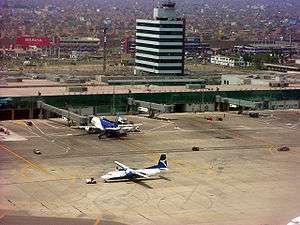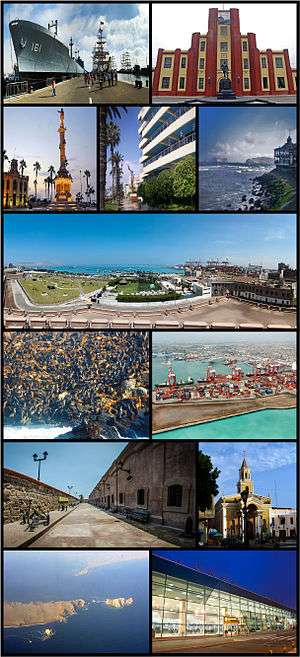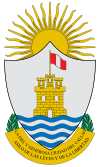Callao
| Callao El Callao | |||
|---|---|---|---|
|
Mozaico Callao | |||
| |||
|
Nickname(s): Pearl from the Pacífic,[1] El Primer Puerto (The First Harbor). | |||
 Callao Location within Peru | |||
| Coordinates: 12°2′S 77°8′W / 12.033°S 77.133°WCoordinates: 12°2′S 77°8′W / 12.033°S 77.133°W | |||
| Country |
| ||
| Region | Callao | ||
| Provinces |
Constitutional Province of Callao | ||
| Founded | 1537 | ||
| Districts |
7 Districts
| ||
| Government | |||
| • Mayor | Félix Moreno | ||
| Area | |||
| • City | 146.98 km2 (56.75 sq mi) | ||
| Population (2011 est)[2] | |||
| • City | 999,976 | ||
| • Urban | 876,877 | ||
| • Urban density | 5,690.4/km2 (14,738/sq mi) | ||
| • Metro | 9,367,587 | ||
| • Demonym | chalaco/a | ||
| Time zone | PET (UTC-5) | ||
| Area code(s) | 14 | ||
| Website | www.municallao.gob.pe | ||
El Callao (/kɑːˈjɑː.oʊ/; Spanish pronunciation: [kaˈʎa.o] or [kaˈʝa.o]) is the chief seaport of Peru. The city is also called Provincia Constitucional (Constitutional Province), the only province of the Callao Region. The Historic Centre of Callao is located 15 km (9.3 mi) west of Historic Centre of Lima, the country's capital, and is part of the Lima Metropolitan Area. Callao borders Lima Province on the north, east and south, and the Pacific Ocean on the west.
History
El Callao was founded by Spanish colonists in 1537, just two years after Lima (1535). It soon became the main port for Spanish commerce in the Pacific. The origin of its name is unknown; both Indian (particularly Yunga, or Coastal Peruvian) and Spanish sources are credited, but it is certain that it was known by that name since 1550. Other sources point to the similarity with the Portuguese word calhau [pebble], having a similar sound.
At the height of the Viceroyalty, virtually all goods produced in Peru, Bolivia, and Argentina were carried over the Andes by mule to Callao, to be shipped to Panama, carried overland, and then transported on to Spain via Cuba.
On 20 August 1836, during the Peru-Bolivian Confederacy, President Andrés de Santa Cruz mandated the creation of the Callao Littoral Province (Provincia Litoral del Callao), which had political autonomy in its internal affairs. During the government of President Ramón Castilla, Callao was given the name of Constitutional Province (Provincia Constitucional), on 22 April 1857; before that, Callao had the name of Littoral Province. All of the other Peruvian provinces had been given their names by law, while Callao was given it by constitutional mandate.
Callao was never part of the Lima Department nor of any other departments.
The province's first mayor was Col. Manuel Cipriano Dulanto.
By 1949, Callao was known as one of the biggest centers of coca-based products and cocaine traffic in the world.[3]
Notable events
- On 28 October 1746, a tsunami caused by an earthquake destroyed the entire port of Callao.
- On 22 January 22, 1826, besieged by nationalist forces backed by Simón Bolívar, General José Ramón Rodil surrendered Callao to General Bartolomé Salom.
- On 2 May 1866, during the Battle of Callao, the Spanish fleet tried to reconquer independent Peru.
- Kon-Tiki left Callao, Peru, on the afternoon of April 28, 1947.
- On 19 June 1986, dozens of Sendero Luminoso terrorists tried to escape but encountered the government's naval forces on El Frontón, resulting in the so-called Peruvian prison massacres.
City highlights
Callao is built on and around a peninsula, the district of La Punta, a wealthy residential neighborhood. A historical fortress, the Castillo de Real Felipe (site of "Rodil's Last Stand"), stands on the promontory overlooking the harbor.
A large naval base is sited in Callao. Its prison holds Abimael Guzmán, the leader of the Shining Path terrorist organization, and Vladimiro Montesinos, the ex-director of internal security during the Fujimori regime.
Jorge Chávez International Airport is located in Callao.
On a bluff overlooking the harbor sits Colegio Militar Leoncio Prado, the military high school. The city also has a university, the National University of Callao.
The main Naval Hospital, Centro Medico Naval is located on Avenida Venezuela in Bellavista. It contains the U.S. Navy command Naval Medical Research Unit Six.
Callao has several islands: San Lorenzo (currently a military base), El Frontón (a former high security prison), the Cavinzas, and the Palominos, where numerous sea lions and sea birds live in a virtually untouched ecosystem. There are proposed plans to build a huge naval, terrestrial, and air port on San Lorenzo Island. This project is called the San Lorenzo Megaport Project.
Residents of Callao are known as chalacos.
Callao's professional football teams are Sport Boys and Atlético Chalaco.
Islands
Airport
Jorge Chávez International Airport (IATA: LIM, ICAO: SPIM), known as Aeropuerto Internacional Jorge Chávez in Spanish, is Peru's main international and domestic airport. It is located in Callao, 12 km (7.5 mi) from the Historic Centre of Lima and 19 km (12 mi) from Miraflores. Callao is the port city now fully integrated with Lima, the nation's capital. In 2008, the airport handled 8,288,506 passengers and 98,733 aircraft movements.
For many years it was the hub for now defunct Aeroperú and Compañía de Aviación Faucett, one of the oldest airlines in Latin America. Now it serves as a hub for many aviation companies such as TACA Perú and LAN Perú.

Government
Local government affairs are divided into two levels. Regional matters are handled by the Regional Government of Callao (Gobierno Regional del Callao), which is located in the Bellavista District. Affairs such as city cleaning, promoting of sports and basic services are handled by the Provincial Municipality of Callao, which is headquartered in the Callao District. Also, each of the six districts has its own Municipality which handles matters in their respective jurisdictional areas.
Districts
Callao is divided into seven districts, (Spanish: distritos; singular: distrito), each of which is headed by a mayor (alcalde).
* The rest of Callao Region is composed of the islands of San Lorenzo, El Frontón and Cavinzas, which all together have an area of 17.63 square kilometres (6.81 sq mi).
Railway
The port is served by the Ferrocarril Central Andino railway, which from 2006 to 2010 was converted from 3 feet (914 mm) gauge to the world standard gauge of 4 ft 8 1⁄2 in (1,435 mm).
In popular culture
- Peruvian author Mario Vargas Llosa attended the military school and referred to it in his first novel, La Ciudad y los Perros (1962) (published in English as The Time of the Hero in 1963). The book was adapted as a film entitled The City and the Dogs (1985). It featured exterior shots of the school.
- Callao is the refuge place for the subjects of the Rudyard Kipling poem The Broken Men.
- Footballer Claudio Pizarro was born in Callao; he is recognized as one of the best Peruvian football players. His nickname, the "Andean Bomber", refers to his provenance in the Andean region and was given to him by Gerd Müller. He is the all-time leading non-German top scorer of the German Bundesliga. Pizzaro currently plays with Werder Bremen.
- Callao was featured in Prisoners of the Sun, part of The Adventures of Tintin, and The Wine-Dark Sea, the sixteenth book in the Aubrey-Maturin series.
References
- ↑ Camara de Comercio de Lima, ed. (2000). "La Perla del Pacífico". Retrieved 9 May 2012.
- ↑ INEI– Censo INEI (2005) Archived 27 April 2006 at the Wayback Machine.
- ↑ "The White Goddess", TIME Magazine, 11 April 1949
External links
| Wikimedia Commons has media related to Callao. |
| Wikivoyage has a travel guide for Callao. |
- Municipality of Callao (in Spanish)
- Chim Pum Callao
- Todo Callao (in Spanish)
- Jorge Chavez International Airport
- National University of Callao (in Spanish)
- Islas Palomino (Palomino Islands) pictures and videos
- Regional government of Callao
- Callao.Net la Internet del Callao (in Spanish)
- Sport Boys Association (unofficial) (in Spanish)
 |
Pacific Ocean | |
San Martín de Porres |  |
| Pacific Ocean | |
Cercado de Lima | ||
| ||||
| | ||||
| Pacific Ocean | Pacific Ocean | San Miguel |


